Paper Menu >>
Journal Menu >>
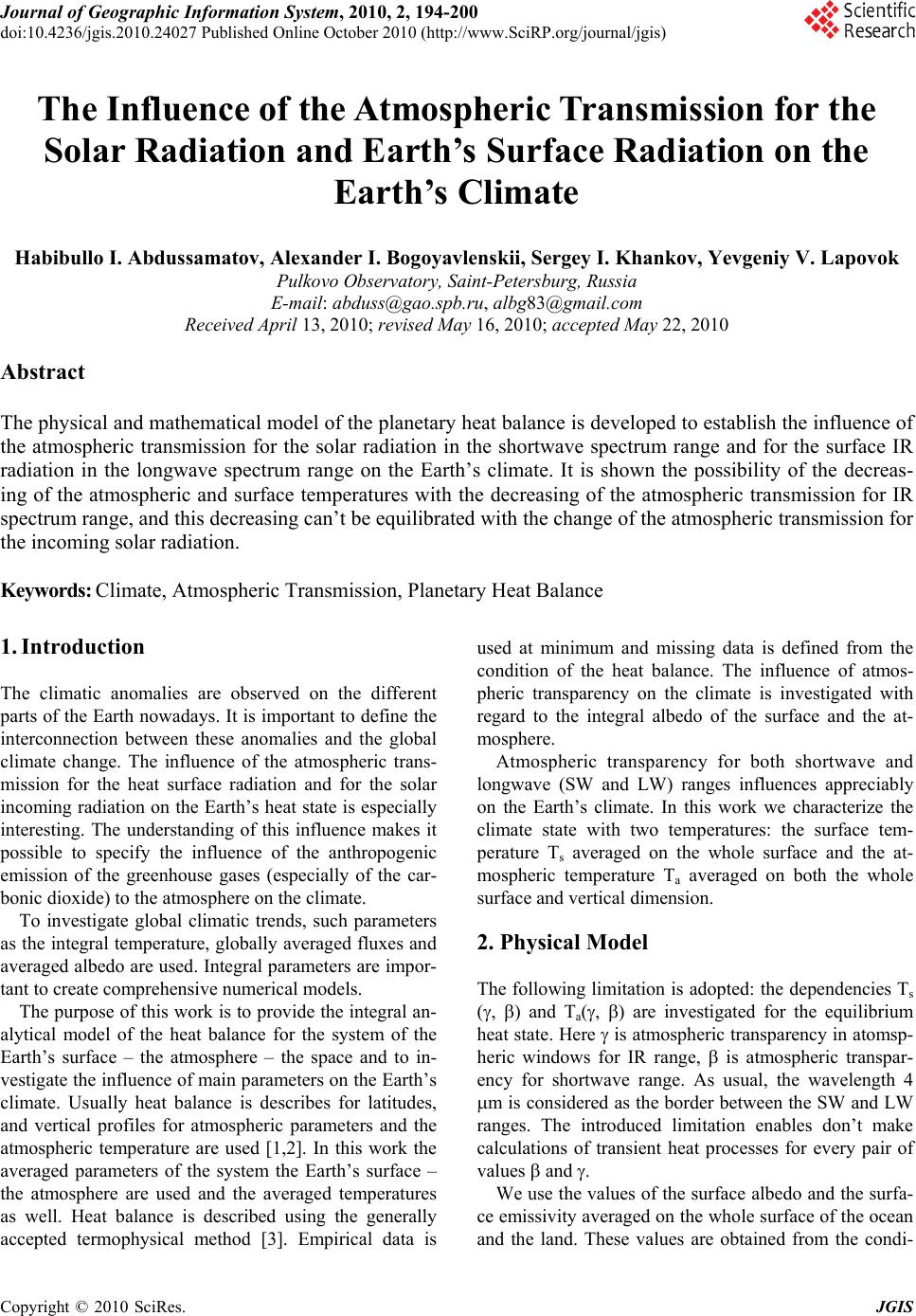 Journal of Geographic Information System, 2010, 2, 194-200 doi:10.4236/jgis.2010.24027 Published Online October 2010 (http://www.SciRP.org/journal/jgis) Copyright © 2010 SciRes. JGIS The Influence of the Atmospheric Transmission for the Solar Radiation and Earth’s Surface Radiation on the Earth’s Climate Habibullo I. Abdussamatov, Alexander I. Bogoyavlenskii, Sergey I. Khankov, Yevgeniy V. Lapovok Pulkovo Observatory, Saint-Petersburg, Russia E-mail: abduss@gao.spb.ru, albg83@gmail.com Received April 13, 2010; revised May 16, 2010; accepted May 22, 2010 Abstract The physical and mathematical model of the planetary heat balance is developed to establish the influence of the atmospheric transmission for the solar radiation in the shortwave spectrum range and for the surface IR radiation in the longwave spectrum range on the Earth’s climate. It is shown the possibility of the decreas- ing of the atmospheric and surface temperatures with the decreasing of the atmospheric transmission for IR spectrum range, and this decreasing can’t be equilibrated with the change of the atmospheric transmission for the incoming solar radiation. Keywords: Climate, Atmospheric Transmission, Planetary Heat Balance 1. Introduction The climatic anomalies are observed on the different parts of the Earth nowadays. It is important to define the interconnection between these anomalies and the global climate change. The influence of the atmospheric trans- mission for the heat surface radiation and for the solar incoming radiation on the Earth’s heat state is especially interesting. The understanding of this influence makes it possible to specify the influence of the anthropogenic emission of the greenhouse gases (especially of the car- bonic dioxide) to the atmosphere on the climate. To investigate global climatic trends, such parameters as the integral temperature, globally averaged fluxes and averaged albedo are used. Integral parameters are impor- tant to create comprehensive numerical models. The purpose of this work is to provide the integral an- alytical model of the heat balance for the system of the Earth’s surface – the atmosphere – the space and to in- vestigate the influence of main parameters on the Earth’s climate. Usually heat balance is describes for latitudes, and vertical profiles for atmospheric parameters and the atmospheric temperature are used [1,2]. In this work the averaged parameters of the system the Earth’s surface – the atmosphere are used and the averaged temperatures as well. Heat balance is described using the generally accepted termophysical method [3]. Empirical data is used at minimum and missing data is defined from the condition of the heat balance. The influence of atmos- pheric transparency on the climate is investigated with regard to the integral albedo of the surface and the at- mosphere. Atmospheric transparency for both shortwave and longwave (SW and LW) ranges influences appreciably on the Earth’s climate. In this work we characterize the climate state with two temperatures: the surface tem- perature Ts averaged on the whole surface and the at- mospheric temperature Ta averaged on both the whole surface and vertical dimension. 2. Physical Model The following limitation is adopted: the dependencies Тs (, ) and Та(, ) are investigated for the equilibrium heat state. Here is atmospheric transparency in atomsp- heric windows for IR range, is atmospheric transpar- ency for shortwave range. As usual, the wavelength 4 m is considered as the border between the SW and LW ranges. The introduced limitation enables don’t make calculations of transient heat processes for every pair of values and . We use the values of the surface albedo and the surfa- ce emissivity averaged on the whole surface of the ocean and the land. These values are obtained from the condi- 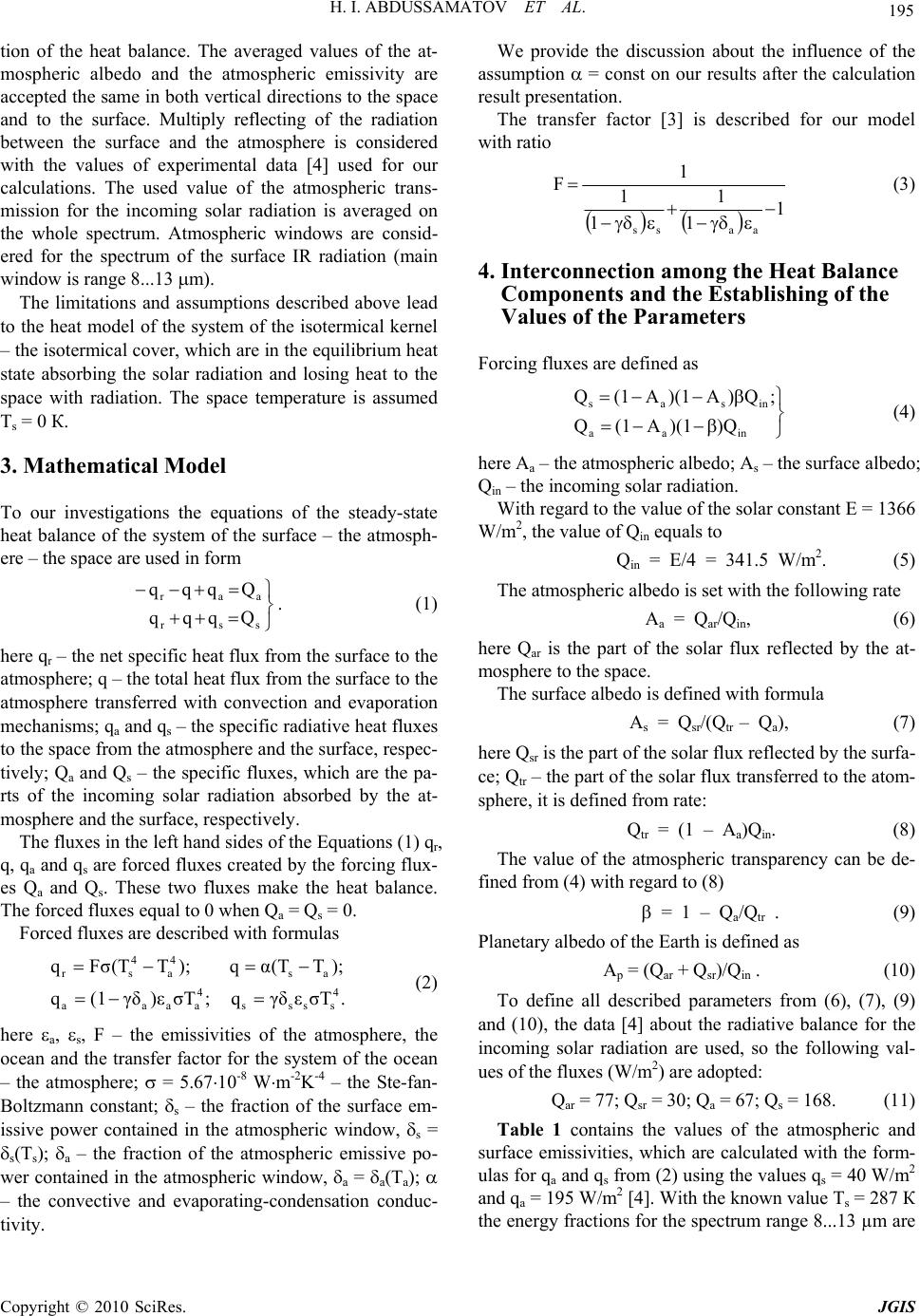 H. I. ABDUSSAMATOV ET AL. Copyright © 2010 SciRes. JGIS 195 tion of the heat balance. The averaged values of the at- mospheric albedo and the atmospheric emissivity are accepted the same in both vertical directions to the space and to the surface. Multiply reflecting of the radiation between the surface and the atmosphere is considered with the values of experimental data [4] used for our calculations. The used value of the atmospheric trans- mission for the incoming solar radiation is averaged on the whole spectrum. Atmospheric windows are consid- ered for the spectrum of the surface IR radiation (main window is range 8...13 m). The limitations and assumptions described above lead to the heat model of the system of the isotermical kernel – the isotermical cover, which are in the equilibrium heat state absorbing the solar radiation and losing heat to the space with radiation. The space temperature is assumed Тs = 0 К. 3. Mathematical Model To our investigations the equations of the steady-state heat balance of the system of the surface – the atmosph- ere – the space are used in form ssr ааr Qqqq Qqqq . (1) here qr – the net specific heat flux from the surface to the atmosphere; q – the total heat flux from the surface to the atmosphere transferred with convection and evaporation mechanisms; qа and qs – the specific radiative heat fluxes to the space from the atmosphere and the surface, respec- tively; Qа and Qs – the specific fluxes, which are the pa- rts of the incoming solar radiation absorbed by the at- mosphere and the surface, respectively. The fluxes in the left hand sides of the Equations (1) qr, q, qa and qs are forced fluxes created by the forcing flux- es Qa and Qs. These two fluxes make the heat balance. The forced fluxes equal to 0 when Qа = Qs = 0. Forced fluxes are described with formulas 44 rsa sa 44 aaaassss qFσ(TT );qα(TT ); q(1γδ )εσT; qγδ ε σT. (2) here а, s, F – the emissivities of the atmosphere, the ocean and the transfer factor for the system of the ocean – the atmosphere; = 5.6710-8 Wm-2K-4 – the Ste-fan- Boltzmann constant; s – the fraction of the surface em- issive power contained in the atmospheric window, s = s(Ts); а – the fraction of the atmospheric emissive po- wer contained in the atmospheric window, a = a(Ta); – the convective and evaporating-condensation conduc- tivity. We provide the discussion about the influence of the assumption = const on our results after the calculation result presentation. The transfer factor [3] is described for our model with ratio 1 1 1 1 1 1 F aass (3) 4. Interconnection among the Heat Balance Components and the Establishing of the Values of the Parameters Forcing fluxes are defined as inaa insas )Q)(1A(1Q ;Q)A)(1A(1Q (4) here Аа – the atmospheric albedo; Аs – the surface albedo; Qin – the incoming solar radiation. With regard to the value of the solar constant Е = 1366 W/m2, the value of Qin equals to Qin = Е/4 = 341.5 W/m2. (5) The atmospheric albedo is set with the following rate Аа = Qаr/Qin, (6) here Qаr is the part of the solar flux reflected by the at- mosphere to the space. The surface albedo is defined with formula Аs = Qsr/(Qtr – Qa), (7) here Qsr is the part of the solar flux reflected by the surfa- ce; Qtr – the part of the solar flux transferred to the atom- sphere, it is defined from rate: Qtr = (1 – Аа)Qin. (8) The value of the atmospheric transparency can be de- fined from (4) with regard to (8) = 1 – Qа/Qtr . (9) Planetary albedo of the Earth is defined as Ap = (Qar + Qsr)/Qin . (10) To define all described parameters from (6), (7), (9) and (10), the data [4] about the radiative balance for the incoming solar radiation are used, so the following val- ues of the fluxes (W/m2) are adopted: Qar = 77; Qsr = 30; Qa = 67; Qs = 168. (11) Table 1 contains the values of the atmospheric and surface emissivities, which are calculated with the form- ulas for qa and qs from (2) using the values qs = 40 W/m2 and qa = 195 W/m2 [4]. With the known value Тs = 287 К the energy fractions for the spectrum range 8...13 µm are 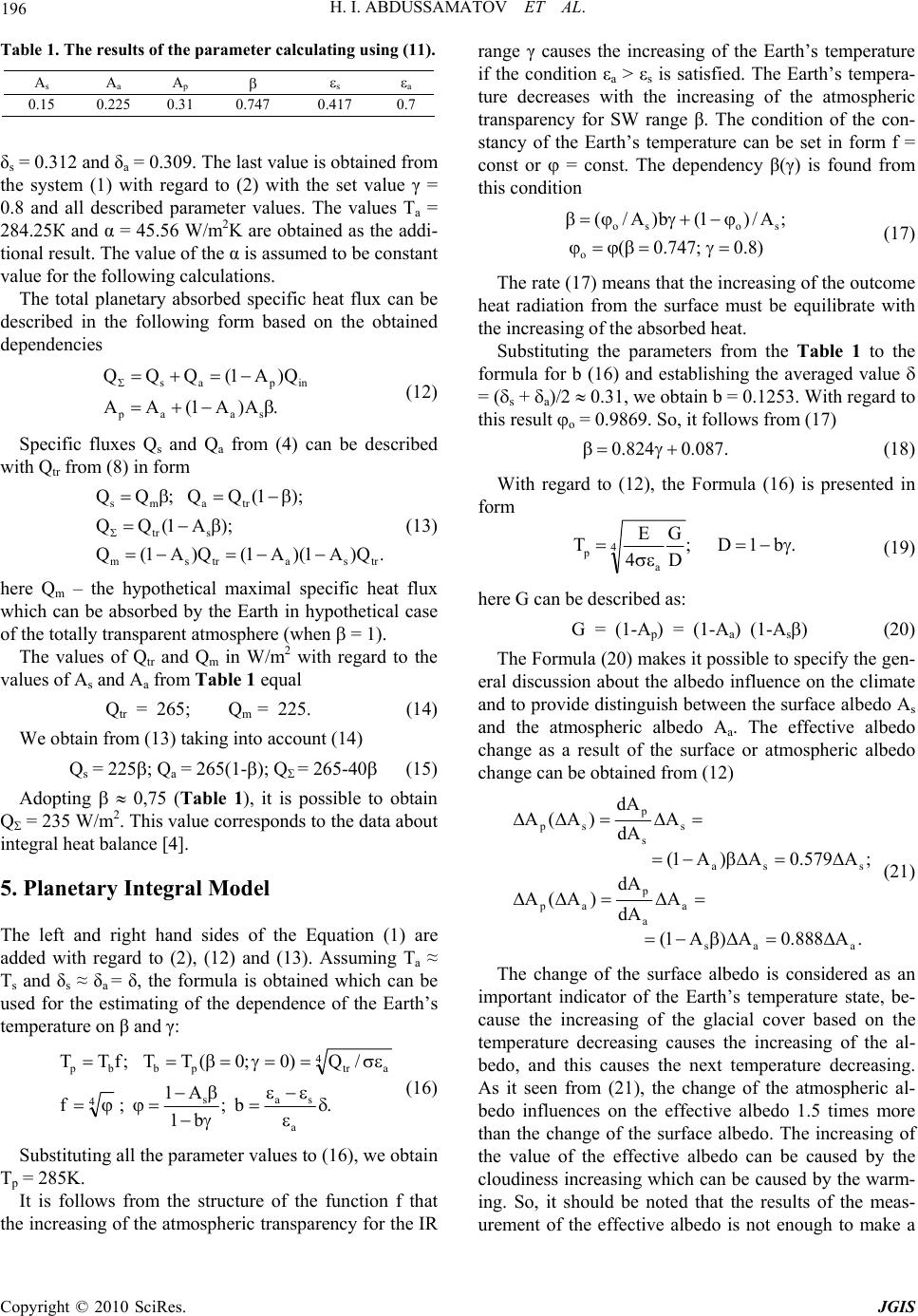 H. I. ABDUSSAMATOV ET AL. Copyright © 2010 SciRes. JGIS 196 Table 1. The results of the parameter calculating using (11). Аs Аa Аp s a 0.15 0.225 0.31 0.747 0.417 0.7 δs = 0.312 and δa = 0.309. The last value is obtained from the system (1) with regard to (2) with the set value γ = 0.8 and all described parameter values. The values Тa = 284.25К and α = 45.56 W/m2K are obtained as the addi- tional result. The value of the α is assumed to be constant value for the following calculations. The total planetary absorbed specific heat flux can be described in the following form based on the obtained dependencies .A)A1(AA Q)A1(QQQ saap inpas (12) Specific fluxes Qs and Qa from (4) can be described with Qtr from (8) in form .Q)A1)(A1(Q)A1(Q );A1(QQ );1(QQ;QQ trsatrsm str trams (13) here Qm – the hypothetical maximal specific heat flux which can be absorbed by the Earth in hypothetical case of the totally transparent atmosphere (when = 1). The values of Qtr and Qm in W/m2 with regard to the values of Аs and Аa from Table 1 equal Qtr = 265; Qm = 225. (14) We obtain from (13) taking into account (14) Qs = 225; Qa = 265(1-); Q = 265-40 (15) Adopting 0,75 (Table 1), it is possible to obtain Q = 235 W/m2. This value corresponds to the data about integral heat balance [4]. 5. Planetary Integral Model The left and right hand sides of the Equation (1) are added with regard to (2), (12) and (13). Assuming Ta ≈ Ts and δs ≈ δа = δ, the formula is obtained which can be used for the estimating of the dependence of the Earth’s temperature on β and γ: .b; b1 A1 ;f /Q)0;0(TT;fTT a sas 4 4atrpbbp (16) Substituting all the parameter values to (16), we obtain Tp = 285K. It is follows from the structure of the function f that the increasing of the atmospheric transparency for the IR range γ causes the increasing of the Earth’s temperature if the condition εa > εs is satisfied. The Earth’s tempera- ture decreases with the increasing of the atmospheric transparency for SW range β. The condition of the con- stancy of the Earth’s temperature can be set in form f = const or = const. The dependency β(γ) is found from this condition )8.0;747.0( ;A/)1(b)A/( o soso (17) The rate (17) means that the increasing of the outcome heat radiation from the surface must be equilibrate with the increasing of the absorbed heat. Substituting the parameters from the Table 1 to the formula for b (16) and establishing the averaged value = (s + a)/2 0.31, we obtain b = 0.1253. With regard to this result o = 0.9869. So, it follows from (17) .087.0824.0 (18) With regard to (12), the Formula (16) is presented in form .b1D; D G 4 E T4 a p (19) here G can be described as: G = (1-Ap) = (1-Aa) (1-As) (20) The Formula (20) makes it possible to specify the gen- eral discussion about the albedo influence on the climate and to provide distinguish between the surface albedo As and the atmospheric albedo Aa. The effective albedo change as a result of the surface or atmospheric albedo change can be obtained from (12) .A888.0A)A1( A dA dA )A(A ;A579.0A)A1( A dA dA )A(A aas a a p ap ssa s s p sp (21) The change of the surface albedo is considered as an important indicator of the Earth’s temperature state, be- cause the increasing of the glacial cover based on the temperature decreasing causes the increasing of the al- bedo, and this causes the next temperature decreasing. As it seen from (21), the change of the atmospheric al- bedo influences on the effective albedo 1.5 times more than the change of the surface albedo. The increasing of the value of the effective albedo can be caused by the cloudiness increasing which can be caused by the warm- ing. So, it should be noted that the results of the meas- urement of the effective albedo is not enough to make a 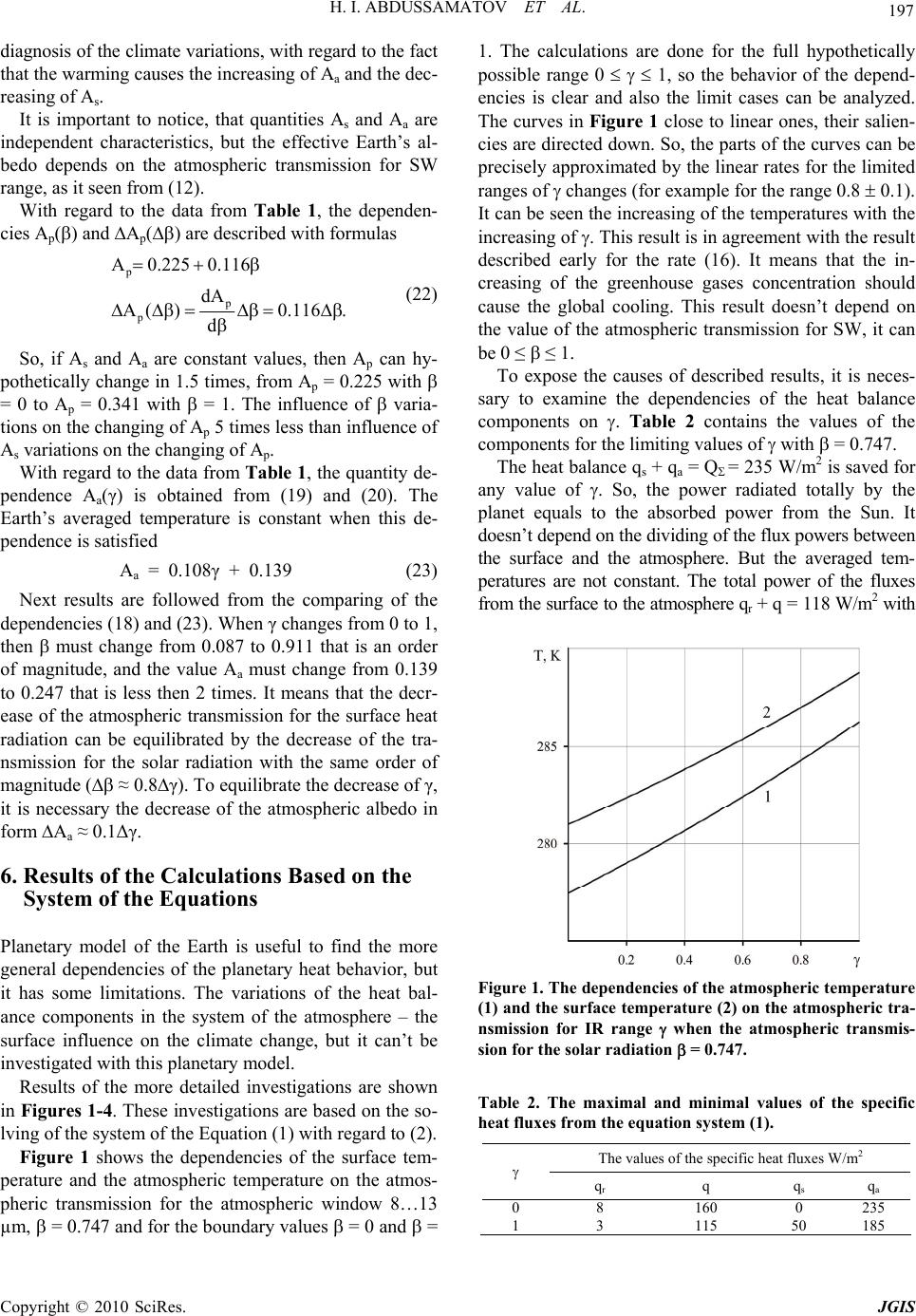 H. I. ABDUSSAMATOV ET AL. Copyright © 2010 SciRes. JGIS 197 diagnosis of the climate variations, with regard to the fact that the warming causes the increasing of Aa and the dec- reasing of As. It is important to notice, that quantities As and Aa are independent characteristics, but the effective Earth’s al- bedo depends on the atmospheric transmission for SW range, as it seen from (12). With regard to the data from Table 1, the dependen- cies Ap() and Аp() are described with formulas .116.0 d dA )(A 116.0225.0A p p p (22) So, if As and Aa are constant values, then Ap can hy- pothetically change in 1.5 times, from Ap = 0.225 with = 0 to Аp = 0.341 with = 1. The influence of varia- tions on the changing of Ap 5 times less than influence of As variations on the changing of Ap. With regard to the data from Table 1, the quantity de- pendence Aa(γ) is obtained from (19) and (20). The Earth’s averaged temperature is constant when this de- pendence is satisfied Aa = 0.108γ + 0.139 (23) Next results are followed from the comparing of the dependencies (18) and (23). When γ changes from 0 to 1, then must change from 0.087 to 0.911 that is an order of magnitude, and the value Aa must change from 0.139 to 0.247 that is less then 2 times. It means that the decr- ease of the atmospheric transmission for the surface heat radiation can be equilibrated by the decrease of the tra- nsmission for the solar radiation with the same order of magnitude ( ≈ 0.8γ). To equilibrate the decrease of γ, it is necessary the decrease of the atmospheric albedo in form Aa ≈ 0.1Δγ. 6. Results of the Calculations Based on the System of the Equations Planetary model of the Earth is useful to find the more general dependencies of the planetary heat behavior, but it has some limitations. The variations of the heat bal- ance components in the system of the atmosphere – the surface influence on the climate change, but it can’t be investigated with this planetary model. Results of the more detailed investigations are shown in Figures 1-4. These investigations are based on the so- lving of the system of the Equation (1) with regard to (2). Figure 1 shows the dependencies of the surface tem- perature and the atmospheric temperature on the atmos- pheric transmission for the atmospheric window 8…13 µm, = 0.747 and for the boundary values = 0 and = 1. The calculations are done for the full hypothetically possible range 0 1, so the behavior of the depend- encies is clear and also the limit cases can be analyzed. The curves in Figure 1 close to linear ones, their salien- cies are directed down. So, the parts of the curves can be precisely approximated by the linear rates for the limited ranges of changes (for example for the range 0.8 0.1). It can be seen the increasing of the temperatures with the increasing of . This result is in agreement with the result described early for the rate (16). It means that the in- creasing of the greenhouse gases concentration should cause the global cooling. This result doesn’t depend on the value of the atmospheric transmission for SW, it can be 0 ≤ ≤ 1. To expose the causes of described results, it is neces- sary to examine the dependencies of the heat balance components on . Table 2 contains the values of the components for the limiting values of with = 0.747. The heat balance qs + qa = Q = 235 W/m2 is saved for any value of . So, the power radiated totally by the planet equals to the absorbed power from the Sun. It doesn’t depend on the dividing of the flux powers between the surface and the atmosphere. But the averaged tem- peratures are not constant. The total power of the fluxes from the surface to the atmosphere qr + q = 118 W/m2 with Figure 1. The dependencies of the atmospheric temperature (1) and the surface temperature (2) on the atmospheric tra- nsmission for IR range when the atmospheric transmis- sion for the solar radiation = 0.747. Table 2. The maximal and minimal values of the specific heat fluxes from the equation system (1). The values of the specific heat fluxes W/m2 qr q qs q a 0 8 160 0 235 1 3 115 50 185 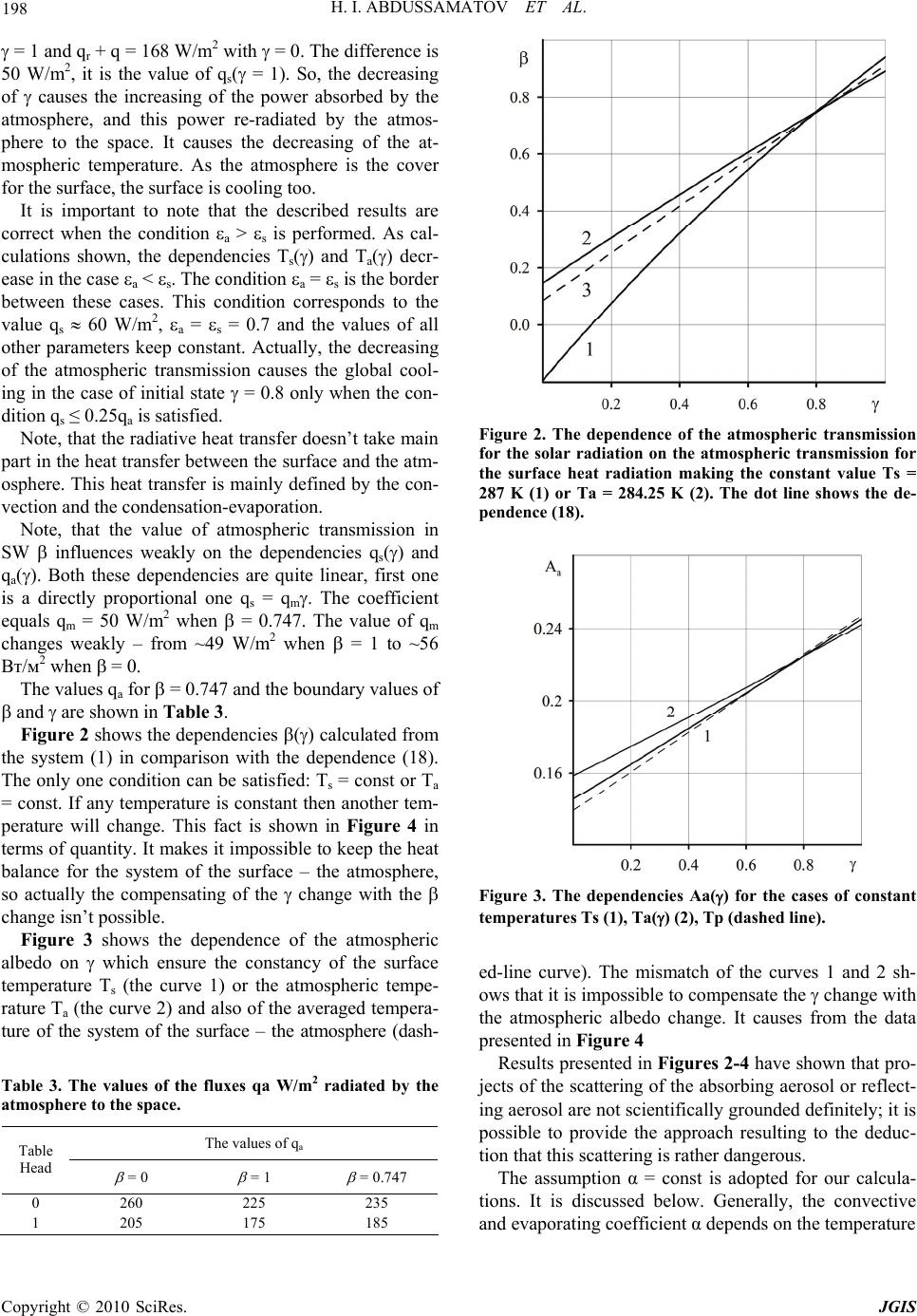 H. I. ABDUSSAMATOV ET AL. Copyright © 2010 SciRes. JGIS 198 = 1 and qr + q = 168 W/m2 with = 0. The difference is 50 W/m2, it is the value of qs( = 1). So, the decreasing of causes the increasing of the power absorbed by the atmosphere, and this power re-radiated by the atmos- phere to the space. It causes the decreasing of the at- mospheric temperature. As the atmosphere is the cover for the surface, the surface is cooling too. It is important to note that the described results are correct when the condition а > s is performed. As cal- culations shown, the dependencies Тs() and Та() decr- ease in the case а < s. The condition а = s is the border between these cases. This condition corresponds to the value qs 60 W/m2, а = s = 0.7 and the values of all other parameters keep constant. Actually, the decreasing of the atmospheric transmission causes the global cool- ing in the case of initial state = 0.8 only when the con- dition qs ≤ 0.25qa is satisfied. Note, that the radiative heat transfer doesn’t take main part in the heat transfer between the surface and the atm- osphere. This heat transfer is mainly defined by the con- vection and the condensation-evaporation. Note, that the value of atmospheric transmission in SW influences weakly on the dependencies qs() and qа(). Both these dependencies are quite linear, first one is a directly proportional one qs = qm. The coefficient equals qm = 50 W/m2 when = 0.747. The value of qm changes weakly – from ~49 W/m2 when = 1 to ~56 Вт/м2 when = 0. The values qа for = 0.747 and the boundary values of and are shown in Table 3. Figure 2 shows the dependencies () calculated from the system (1) in comparison with the dependence (18). The only one condition can be satisfied: Ts = const or Ta = const. If any temperature is constant then another tem- perature will change. This fact is shown in Figure 4 in terms of quantity. It makes it impossible to keep the heat balance for the system of the surface – the atmosphere, so actually the compensating of the change with the change isn’t possible. Figure 3 shows the dependence of the atmospheric albedo on which ensure the constancy of the surface temperature Ts (the curve 1) or the atmospheric tempe- rature Ta (the curve 2) and also of the averaged tempera- ture of the system of the surface – the atmosphere (dash- Table 3. The values of the fluxes qа W/m2 radiated by the atmosphere to the space. The values of qа Table Head = 0 = 1 = 0.747 0 260 225 235 1 205 175 185 Figure 2. The dependence of the atmospheric transmission for the solar radiation on the atmospheric transmission for the surface heat radiation making the constant value Ts = 287 K (1) or Ta = 284.25 K (2). The dot line shows the de- pendence (18). Figure 3. The dependencies Aa() for the cases of constant temperatures Ts (1), Ta() (2), Tp (dashed line). ed-line curve). The mismatch of the curves 1 and 2 sh- ows that it is impossible to compensate the change with the atmospheric albedo change. It causes from the data presented in Figure 4 Results presented in Figures 2-4 have shown that pro- jects of the scattering of the absorbing aerosol or reflect- ing aerosol are not scientifically grounded definitely; it is possible to provide the approach resulting to the deduc- tion that this scattering is rather dangerous. The assumption α = const is adopted for our calcula- tions. It is discussed below. Generally, the convective and evaporating coefficient α depends on the temperature 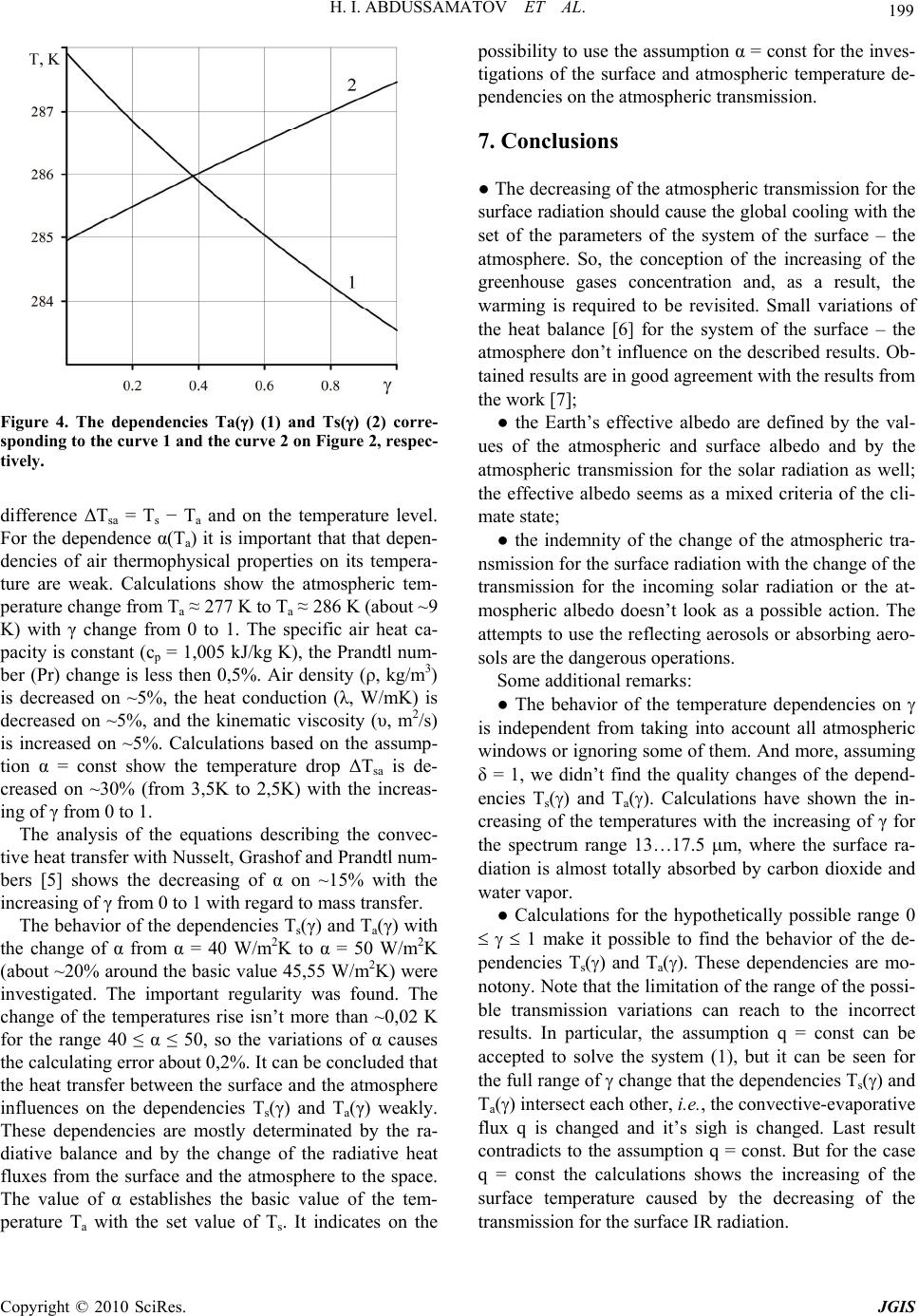 H. I. ABDUSSAMATOV ET AL. Copyright © 2010 SciRes. JGIS 199 Figure 4. The dependencies Ta() (1) and Ts() (2) corre- sponding to the curve 1 and the curve 2 on Figure 2, respec- tively. difference ΔTsa = Ts − T a and on the temperature level. For the dependence α(Та) it is important that that depen- dencies of air thermophysical properties on its tempera- ture are weak. Calculations show the atmospheric tem- perature change from Ta ≈ 277 K to Ta ≈ 286 K (about ~9 K) with γ change from 0 to 1. The specific air heat ca- pacity is constant (cp = 1,005 kJ/kg K), the Prandtl num- ber (Pr) change is less then 0,5%. Air density (ρ, kg/m3) is decreased on ~5%, the heat conduction (λ, W/mK) is decreased on ~5%, and the kinematic viscosity (υ, m2/s) is increased on ~5%. Calculations based on the assump- tion α = const show the temperature drop ΔTsa is de- creased on ~30% (from 3,5K to 2,5K) with the increas- ing of γ from 0 to 1. The analysis of the equations describing the convec- tive heat transfer with Nusselt, Grashof and Prandtl num- bers [5] shows the decreasing of α on ~15% with the increasing of γ from 0 to 1 with regard to mass transfer. The behavior of the dependencies Ts(γ) and Ta(γ) with the change of α from α = 40 W/m2K to α = 50 W/m2K (about ~20% around the basic value 45,55 W/m2K) were investigated. The important regularity was found. The change of the temperatures rise isn’t more than ~0,02 K for the range 40 ≤ α ≤ 50, so the variations of α causes the calculating error about 0,2%. It can be concluded that the heat transfer between the surface and the atmosphere influences on the dependencies Ts(γ) and Ta(γ) weakly. These dependencies are mostly determinated by the ra- diative balance and by the change of the radiative heat fluxes from the surface and the atmosphere to the space. The value of α establishes the basic value of the tem- perature Ta with the set value of Ts. It indicates on the possibility to use the assumption α = const for the inves- tigations of the surface and atmospheric temperature de- pendencies on the atmospheric transmission. 7. Conclusions ● The decreasing of the atmospheric transmission for the surface radiation should cause the global cooling with the set of the parameters of the system of the surface – the atmosphere. So, the conception of the increasing of the greenhouse gases concentration and, as a result, the warming is required to be revisited. Small variations of the heat balance [6] for the system of the surface – the atmosphere don’t influence on the described results. Ob- tained results are in good agreement with the results from the work [7]; ● the Earth’s effective albedo are defined by the val- ues of the atmospheric and surface albedo and by the atmospheric transmission for the solar radiation as well; the effective albedo seems as a mixed criteria of the cli- mate state; ● the indemnity of the change of the atmospheric tra- nsmission for the surface radiation with the change of the transmission for the incoming solar radiation or the at- mospheric albedo doesn’t look as a possible action. The attempts to use the reflecting aerosols or absorbing aero- sols are the dangerous operations. Some additional remarks: ● The behavior of the temperature dependencies on is independent from taking into account all atmospheric windows or ignoring some of them. And more, assuming δ = 1, we didn’t find the quality changes of the depend- encies Ts() and Tа(). Calculations have shown the in- creasing of the temperatures with the increasing of γ for the spectrum range 13…17.5 m, where the surface ra- diation is almost totally absorbed by carbon dioxide and water vapor. ● Calculations for the hypothetically possible range 0 1 make it possible to find the behavior of the de- pendencies Ts() and Ta(). These dependencies are mo- notony. Note that the limitation of the range of the possi- ble transmission variations can reach to the incorrect results. In particular, the assumption q = const can be accepted to solve the system (1), but it can be seen for the full range of change that the dependencies Ts() and Ta() intersect each other, i.e., the convective-evaporative flux q is changed and it’s sigh is changed. Last result contradicts to the assumption q = const. But for the case q = const the calculations shows the increasing of the surface temperature caused by the decreasing of the transmission for the surface IR radiation.  H. I. ABDUSSAMATOV ET AL. Copyright © 2010 SciRes. JGIS 200 8. References [1] S. Manabe and R. F. Strickler, “Thermal Equilibrium of the Atmosphere with a Convective Adjustment,” Journal of Atmospheric Science, Vol. 21, Vol. 6, 1964, pp. 361- 385. [2] V. Ramanathan, “The Role of Ocean-Atmosphere Inter- actions in the CO2 Climate Problem,” Journal of Atmos- pheric Science, Vol. 38, Vol. 5, 1981, pp. 918-930. [3] H. John, I. V. Lienhard and V. Lienhard, “A Heat Trans- fer Textbook,” 3rd Edition, Phlogiston Press, Cambridge, 2008. [4] J. T. Keihl and K. E. Trenberth, “Earth’s Annual Global Mean Energy Budget,” Bulletin of the American Meteorological Society, Vol. 78, No. 2, 1997, pp. 97-208. [5] E. R. G. Ekkert and R. M. Drake, Jr., “Analysis of Heat and Mass Transfer,” Hemisphere Publishing Corp., Washington, D.C., 1987. [6] K. E. Trenberth, J. T. Fasullo and J. T. Keihl, “Earth’s Global Energy Budget,” Bulletin of the American Mete- orological Society, Vol. 90, No. 3, 2009, pp. 311-323. [7] G. V. Chilingar, L. F. Khilyuk and O. G. Sorokhtin, “Co- oling of Atmosphere Due to CO2 Emission,” Energy So- urces, Part A: Recovery, Utilization, and Environmental Effects, Vol. 30, No. 1, 2008, pp. 1-9. |

